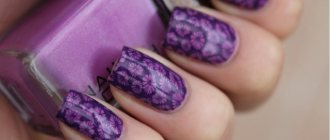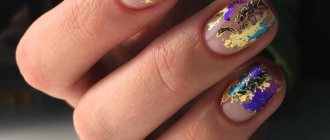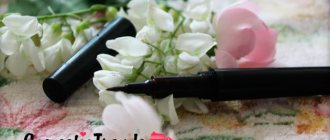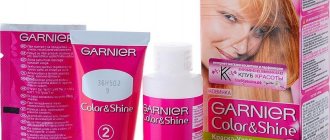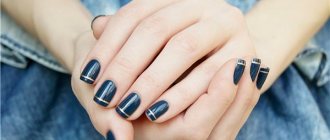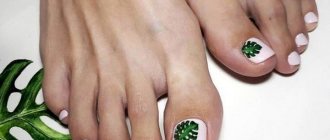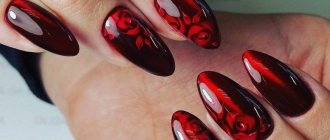Advantages of acrylic paints
There are many reasons why acrylic nail paints are so popular in nail art. Main advantages:
- Convenient to use, can be diluted with water.
- It dries quickly, making it easy to create multi-layered designs.
- Color fastness to ultraviolet.
- Huge selection of color palettes. By mixing different tones you can create any desired shade.
- The pattern is durable and does not crack, maintaining its appearance for up to 1.5 months.
- Acrylic is flexible, so there are several painting technologies. The product is used not only by professional nail artists, but also by those who like to experiment with manicure at home.
- Using acrylic, 3D and 4D drawings are created.
- It is easy to wash off and adjust the pattern until you get the perfect result.
- Non-toxic composition, practically odorless.
- Easily removed without the use of solvent.
- Does not damage the nail plate.
- Used on natural and extended nails.
- Economically used. If used twice a week, a pack of tubes of primary colors will last for a year.
The price for these products is low, especially if you buy the product individually. For example, the cost of a black tube from the Irisk brand, with a volume of 12 ml, is about 60 rubles. But, it is more profitable and expedient to buy a set. The table shows several popular manufacturers, indicating the average prices for a set of 12 tubes:
| Name |
| ruNail, Meskalito |
How to paint on nails with acrylic paints
Manicure with acrylic paints takes place in several stages. Prepare the nail plate so that the pattern is easy to apply and adheres firmly:
- Do a standard manicure: buff your nails, shape them and trim the cuticles.
- Degrease your nails with a special product or alcohol.
- Apply a base so that the design sticks to it and does not get absorbed into the nail plate.
- When the base is dry, remove the sticky layer.
- Treat the nail with a buff to create a matte finish, wipe again with the product to remove “sawdust” and begin applying the design.
Follow certain rules to use the set economically. Remember three important points:
- the product dries quickly, so squeeze it out in small portions;
- do not leave the tube open;
- always check the expiration date before purchasing;
- store the kit under the conditions specified by the manufacturer.
What to breed
There are two types of paints: thick and liquid. Thick acrylic is diluted with ordinary clean water. Liquid – comes in tubes and is immediately ready for use. But, after a while, even acrylic in tubes can become thicker, so it is also diluted. Nail art specialists dilute acrylic paints for painting on nails to create a pattern using a specific technique:
- Watercolor. Acrylic is diluted with water to make the final design transparent or translucent. Forming a tinted aqueous composition, the background, small details, outline and stains between shades are drawn. French, together with this technique, turns out to be very delicate and beautiful; lilies, peonies, roses and other flowers are painted on the nails in discreet colors.
- Pastose. Acrylic is diluted if necessary. In this technique, it is important that the strokes maintain their shape, texture and size. You can collect 2-3 shades on a brush for painting, which should practically not touch each other.
- Oily. Acrylic does not dilute. This is the most popular technique in which the result resembles oil strokes on canvas. To do this, use a thin small brush, with which you can stretch several colors over the nail plate.
How to dry
Acrylic-based paints do not require drying in an ultraviolet lamp. The composition dries on the nails very quickly, within a few seconds. It remains moist on the brush for several minutes due to quantity and moisture. Do not forget to thoroughly wash your painting tools, otherwise once they dry they will become unsuitable for further use.
Tools
Before you start painting, make sure that in addition to the acrylic set, you have all the necessary tools on the table. To work you will need several things:
- brushes – kolinsky or elastic nylon from 00 to 2;
- gel polishes – base, base color and finish;
- lint-free cloth - for cleaning the brush from excess moisture;
- a container of water - to rinse and wet the brushes;
- palette - to dilute and mix shades. Even a piece of plastic will work as a palette.
If you are a beginner, get some tips, cardboard, or practice cards to get some practice. Using these items, you can quickly fill your hand, after which the design will be applied without unnecessary movements and smudging. In addition to floral arrangements, try creating popular animal colors such as zebra, tiger or python. They have been trending for a long time and are easy to apply.
Step-by-step instruction
Having done a standard manicure and prepared the nail plate according to the above principle, you can begin painting. To do this, you need to follow simple recommendations:
- Squeeze some paint onto the palette and close the tube tightly.
- Wet the brush in water and remove excess moisture with a napkin.
- Dip the brush into the paint, adjusting the saturation and density of the color with water.
- Make sure to always keep the brush wet during the process.
- If the drawing does not work out, remove the errors with a cotton swab.
- Wait until the pattern is completely dry and apply topcoat.
- Dry the nails in a UV lamp, and at this time put the brush in water.
- Wash the instrument thoroughly in hot water and then dry it carefully.
Video
Modern nail art uses a wide variety of materials, using which you can create an almost imperceptible delicate and light pattern, as well as bright, eye-catching designs, make the coating translucent with light lace, or decorate your nails with paintings worthy of the title of masterpiece. One of these materials is gel nail paints.
Gel paint or gel nail paint is a thick, plastic substance with high pigmentation. This substance does not bubble or spread. Just like acrylic used for nail extensions, it polymerizes under the influence of ultraviolet lamp radiation for a maximum of two minutes. The properties of this substance allow you to create super nail designs. When working with gel paints, the master can take his time, fearing that the material will harden, and carefully draw every detail of the design or element of the pattern. Gel nail paint is a universal material. You can paint with gel paints on both natural and extended nails of any shape and length. You can make both Chinese and elegant French manicures with gel paints, and also use them for aquarium design. In 2020, French nail design is a combination of poorly compatible design elements, colors and patterns. The classic white tips of the nails are giving way to dark, black, foil, silver colors, various intricate ornaments and patterns that highlight the free edge of the nail. Today, making a French gel paint does not mean drawing simple white or colored stripes on the free edge of the nail, but also skillfully choosing patterns, rhinestones, sparkles, foil for them, in a word, it is interesting to play with the classic version of this type of nail design, beloved by many girls.
The difference between gel paints and gel polishes
Gel paints and gel polishes are often confused with each other. They are similar only in the presence of a gel in the base and some consonance in the names. As for the differences between these materials, they are as follows:
- Gel based paints do not require stirring. Gel polishes need to be stirred, even if they have not been used for just one day.
- Gel paints have a very dense consistency, which does not allow the coloring pigment to sink to the bottom of the jar, and also ensures economical consumption of material.
- The paints have high pigmentation, which means the most saturated and bright colors. To obtain a rich color using gel polishes, you need to apply them in several layers, which is reflected in the thickness of the nail coating.
- Gel paints can be used to paint the finest and smallest elements and details of a design.
- The paints have a rich color palette.
What do you need to design your nails with gel paints?
In order to make designs on nails with gel paints you will need the following set of tools:
- Thin brushes. These can be either manicure brushes or art brushes.
- Dots. This tool is used for drawing colors, patterns, and dotted images.
- Palette. Using a plastic palette, a piece of plastic or foil paper, you can mix paints and get new shades and colors.
- UV lamp. Without this lamp, the gel nail paint will not harden or dry, which means that no nail design will work.
- Buff or polisher. It is used to remove the glossy layer from nails.
- Degreaser or cleanser.
- Primer.
- Gel polish base and top coat.
Job
In many ways, working with acrylic paints is similar to working with watercolor paints. This is due to their characteristics. Such paints are easily washed out with water; using water you can achieve smooth transitions and transparent shades. However, this same characteristic also has a negative side - they are easily washed off with simple hand washing. Therefore, they must be covered with a protective top, and the free edge must be carefully sealed.
Acrylic paints mix very easily with each other (again, like watercolor). This allows you to obtain a wide variety of colors and shades with their help. Colors can be whitened, brightened, darkened, made more saturated, created new ones, etc. This makes it possible to create new and interesting colors and additional shades. Thanks to this property, a set of acrylic nail paints can be quite small. However, this does not reduce the variety of colors and shades.
The peculiarity of applying paint is that to create a more or less complex design you need to have several brushes. Paints of the required shades are poured onto the palette close to each other and mixed so as to create a color transition (as in ombre). Then the brush is lowered into the paint. In this case, the pre-mixed paint remains on the brush and all that remains is to transfer it to the nail. The most professional and experienced craftsmen can mix and blur shades directly on the plate, but this is quite difficult. Mixing on the palette and having the right brushes is the key to quality Chinese painting.
As for the background on which the pattern is made, it is better to paint it with simple nail polish. The fact is that no matter what acrylic nail paints are better or worse, any of them need to be worked in one step. When applying one layer to another, the first layer may blur and the color will not turn out as expected, in addition, you can completely ruin the entire manicure. This rule is especially relevant for beginners.
[yandex2] [google2]
Step-by-step instructions for painting on nails
The texture and properties of gel paints for nail design allow you to create beautiful designs not only in a beauty salon, but also at home. For this purpose, it is necessary to carry out all hygienic procedures with the nails, treat them with a buff, degrease the nail plates, apply a primer, then a thin layer of base, which must be dried in a UV lamp. After this, gel paint or gel polish is applied. Next, you can apply drawings and patterns to the surface of the nails. Let's take a step-by-step look at how to paint on nails using gel paints:
- Take thin brushes (to reduce the thickness of the brush to the desired size, you can carefully cut off the bristles with a blade) and select the colors of paints that you will use. You can mix colors both on the palette and on the nail plate, getting an interesting avant-garde design.
- When a drawing or pattern is drawn in detail and completed, it can be supplemented with sparkles, rhinestones, stickers, and foil.
- Having applied all the decorative elements and made the finishing touches, you can dry the resulting drawings in an ultraviolet lamp.
- To secure the nails, they are covered with a topcoat, from which the sticky layer is removed after drying.
Options for designs on nails using gel paints
Nail design is not difficult to create, but this process will require some experience. Masters use different techniques to create original patterns, from which a beginner can choose the simplest method in his opinion and gradually develop his skills, bringing it to perfection. Nail design step by step for beginners looks like this (we will omit the description of standard hygienic procedures for preparing nails and covering them with base and gel polish):
- The simplest pattern that a novice master can master is the application of horizontal thin stripes, curls, and “lattices.” For this purpose, gel paint for a French jacket is perfect, which is also considered one of the simplest types of design.
- By dipping the dots into gel paint, you can decorate your nails with a dotted pattern. You can use paint of one color or several colors for this. The dots can be carefully connected to each other and get an interesting pattern.
- By drawing a smile line on the free edge of the nail, you will get a beautiful, delicate jacket. If you make a “reverse French” or an inverted French, the design of the nails will also be very original. In this case, the contrasting color fills the hole space of the nail.
- By carefully placing small dots with dots so that they form a geometric pattern, you can get a delicate, beautiful manicure - a “veil”.
Having mastered simple drawing methods, you will gradually be able to learn more complex techniques of drawing on nails. Many of them do not require good artistic abilities at all. All you need is imagination, precision and the desire to experiment.
Depositphotos/kanzefar
The industrial use of acrylic paints began quite a long time ago, but nail art design specialists appreciated their advantages only in this decade. This is due to the appearance on the Russian market of new high-quality acrylic paints with a thin, but at the same time opaque texture. Since then, manicurists can no longer imagine nail art without acrylic paints.
Want to learn how to use acrylic nail paints? Read on!
Paintings on nails with acrylic paints: photo gallery
We invite you to see a variety of ideas and designs with acrylic paints; the most beautiful and stylish options will inspire you to create your own manicure.
Acrylic nail paints have been used in industry for a long time. More recently, nail art professionals have discovered they have a lot of advantages that they have always been famous for. This is primarily due to the fact that acrylic products with an opaque and rather fine texture have appeared on the modern market, which has attracted the interest of specialists.
Nowadays, manicurists simply cannot imagine their work without acrylic paints.
And this is not surprising, because they are used in almost all master classes and individual work, due to their advantages over other means.
Advantages of acrylic nail paints
Compared to varnish painting, which was more common before the advent of acrylic paints, the advantages of the new technique are obvious:
- ease of use
- color saturation
- Density of application even in thin lines
- and, most importantly, complete
This is not to mention the fact that when using nail polish in art design, mixing colors to obtain new shades is almost impossible, but when using acrylic paints, you can mix anything without any restrictions.
Moreover, complete drying of paints occurs almost instantly, which allows you to avoid waiting time to apply a fixative, as is the case with varnishes.
We've sorted out the advantages. Now let's figure out how to properly use acrylic nail paints.
Adviсe
In order to beautifully design your nails, you need to follow the advice of professionals:
- You should not mix paints from different manufacturers, as the effect may be unexpected;
- it is necessary to purchase hard brushes made of synthetic materials, since acrylic is a heavy material and an ordinary brush will not cope with it (it will be impossible to draw a clear line);
- When mixing colors, it is worth remembering that some shades look darker when dry;
- To prevent acrylic from drying out quickly, it should be moistened with water from a spray bottle.
If you master a simple technique for working with acrylic paints, then countless possibilities will open up for the master. An amazing and colorful palette will allow you to create real masterpieces. Don't be afraid to experiment and try new things.
To learn how to use acrylic paints, see the following video.
Nail design is a fashionable popular trend. Single-color nails have long ceased to be the only possible option for manicure design. Modern fashionistas like complex patterns and intricate designs much more. Acrylic nail paints are widely used to create these most complex and intricate designs. You can purchase them both in stores that sell manicure accessories and in art salons.
Acrylic nail paint sets
Acrylic paints have long been popular with professional and amateur artists. They are used not only for painting nails. Acrylic paints are perfect for painting ceramics, fabric, wood, and glass. Some masters even manage to use acrylic drawings in interior design. So, the main advantage of acrylic nail paints can be considered their versatility.
This material has many other advantages:
- Firstly, acrylic paints are affordable. At the same time, the quality of the material is always at the same level.
- Secondly, of course, a rich color palette. Bright colors and a huge number of their shades allow you to bring completely crazy ideas to life.
- One cannot fail to note the quality of the material. Acrylic paints applied to nails dry quickly and adhere firmly, without peeling even with regular contact with water.
Types of acrylic paints for nail extensions
As practice has shown, acrylic paints are best suited for nail design. Different types of paints allow you to create works that are completely different from each other:
- A huge group that includes almost all materials is water-based acrylic nail paints. They come in different consistencies. In nail services, materials of medium and weak consistency are usually used. The latter are simply ideal for delicate watercolor paintings.
- Popular acrylic nail paints Polycolor are created on the basis of a special viscous resin. Due to this, special brightness and color saturation is achieved. They are suitable for all surfaces without exception. Polycolor paints are characterized by extreme durability. They feel great in different climatic conditions and are not susceptible to chemicals.
- 3D acrylic nail paints are very thick and viscous. Craftsmen use them to make popular three-dimensional paintings. Works made with 3D paints look like real works of art.
How to work with acrylic nail paints?
Acrylic paints are easy to work with and do not require special tools.
Most artists use nylon brushes with elastic bristles, especially for drawing thin contour lines. And for filling large surfaces, flat proteins or a column are suitable. Brushes do not require special cleaning when working; the main thing is not to forget to rinse them in water in a timely manner, since dried paint no longer dissolves and can deform the pile. Accordingly, you can say goodbye to the unique tool of the “nail creator”. How long does acrylic nail paint take to dry?
The specific drying time depends solely on the manufacturer. However, if you apply a pattern to your nails in a thin, narrow layer, the acrylic paint usually dries within a few seconds. Much more paint “hangs” on the brush, which increases the drying time to several minutes.
According to their covering properties, acrylic paints can be divided into several types: transparent, dense and translucent. Separately, we can also distinguish pastel paints, formed by mixing color with white. However, experienced craftsmen, as a rule, independently combine colors on the palette, achieving the required shade. Of the paints with additional decorative effects, nail technologists are especially fond of “metallics” and shades of pearls, which, even with a small addition to the design, give it a special and even chic look.
But whether the paint is glossy or matte does not matter at all, because according to design technology, any decorative coating is still additionally secured with a fixative, which gives the necessary shine and evens out the surface of the nail.
The basic colors, without which a true professional cannot exist, are red, blue, yellow, black and white. All the rest, as we know from a school drawing course, can be obtained through mixing. But since one of the most common motives for nail design is floristry, masters prefer to have green on hand as well. At the same time, it is not at all necessary to buy a large set; 6 colors are enough for full-fledged work. The only thing worth considering is that white color tends to run out faster than others, so you will have to purchase it in larger quantities and preferably from the same brand as the existing palette. This will eliminate the appearance of marble effect and unexpected extraneous shades when mixing.
How to work with acrylic paints correctly?
Before creating a nail design with acrylic paints, be sure to remove the old coating and perform a mechanical manicure. A step-by-step drawing on nails with acrylic paints is created as follows:
- the cuticle is pushed back or removed;
- the surface of the nail is polished;
- the free edge is given the desired length and shape;
- the marigolds are thoroughly degreased;
- base coat is applied;
- a drawing is created (using the selected application technique);
- If the result is satisfactory, a fixative is applied.
Nail design with acrylic paints step by step for beginners is not too different. But it is worth remembering that acrylic is difficult to remove from skin and clothing after drying, so if it gets on your fingers, it is better to solve the problem immediately.
To work with such paints you do not need special tools. It is enough to have several brushes of varying thicknesses with you. Ideally, these should be nylon brushes - they have more elastic and thinner bristles. This will allow you to draw clear and thin lines. But it should be remembered that after finishing painting, the brushes must be thoroughly rinsed under water and allowed to dry.
Application techniques
The versatility of acrylic paints allows you to work with them in a variety of techniques.
Thanks to the density and ability to maintain the texture of strokes, you can achieve the effect of oil paints, but it is worth considering that without a miraculous “top” coating, such a design will be short-lived, and the applied colorless varnish will smooth out the surface. The watercolor design technique with acrylic paints is less common, but also possible. For such work, the surface of the nail must be primed with one layer of paint; as a rule, white is used for this. Otherwise, it will simply roll off the glossy surface. This primer will not take much time, since drying the layer does not require more than 3 minutes.
Sliding technique
, which nail technologists included in their arsenal not so long ago, allows you to get an almost three-dimensional image. Its base is acrylic paints mixed with construction gel. The color obtained in this way not only becomes especially bright, but also acquires volume, which is actively used in the technique of aquarium gel design and in gel bas-relief modeling. Unfortunately, this technique is not available to masters who do not have an ultraviolet lamp, because without it the gel will not harden on the nails and will not retain its properties. In general, the layer-by-layer application of the design, diluted with layers of transparent material, looks truly mesmerizing.
Glazing
nail designers use it more often than they think, even if they are not familiar with the term itself. In nail painting, this technique allows you to add a perspective effect even in a flat design. By the way, da Vinci used layer-by-layer application of translucent tones for a volume effect.
How to remove acrylic paint from nails, clothes and hand skin?
There are a few things to consider when working with acrylic paints.
Paints that are easily diluted with water before drying are no longer afraid of water after drying. Therefore, if they come into contact with clothing during work, Gel paints have been used for nail designs for many years, but questions about the material do not lose their relevance. What is the difference between gel paint and gel polish?
How to apply and remove designs from nails? Is it possible to paint nails with gel paint, or is the material only suitable for drawings?
Paint and shellac are often called interchangeable products, but this does not indicate their identity.
The following properties are considered characteristic of gel paints:
- Brightness - in manicure, paint is usually applied in one layer;
- Thickness - you can safely draw designs without worrying that the composition will flow or dry out;
- Uniformity - the pigment is evenly distributed in the composition and does not settle to the bottom.
At the same time, there is a similarity with gel polishes.
Both materials:
- polymerize under the influence of UV or LED lamps;
- stays on nails for a long time;
- allow you to create the most current nail designs.
Another advantage of gel paints is easy mixing of colors. The master, like a real artist, can create his own palette of shades, delighting clients with exclusive paintings and unusual combinations.
How to apply gel paint: paint your nails or paint on them?
When the material appeared, it was used for only one purpose: creating artistic decoration.
The experts themselves advise paying attention to two aspects:
- Preparing the nail plate.
- Maintaining the correct order of layers.
Preparing your nails for a gel manicure is a serious undertaking.
In addition to removing the cuticle and banal actions to correct the shape, you will need:
- cleaning the natural gloss of the nail with a buff;
- degreasing – fresher;
- “primer” for better adhesion - a primer without acids in the composition.
There are several options for applying layers:
- simple coloring – base for gel polish, 1-2 layers of gel paint, top;
- complex manicure - base, acrylic powder to strengthen nails, base, 2-3 very thin layers of gel paint, topcoat.
We must not forget that gel paint requires mandatory polymerization, so after each layer you must place your nails under a manicure lamp: under UV for 2 minutes, under LED for 30 seconds.
When painting your nails, it is best to use a flat brush to ensure even application. The paint is applied in a small amount and spread over the nail in the manner of gel polish.
To draw the designs you will need a thin brush. For paints with gel compositions, artists usually choose column brushes or synthetic brushes of size 0-2.
Paint with gel paints on gel polish
very simple. First, follow the steps of the classic gel manicure. Then the master creates a design of your choice using gel polish.
Further manipulations depend on the type of decor:
- volumetric lines are polymerized, but the top coat is usually applied not on top, but in front of the pattern;
- flat patterns require a finishing coat and sequential drying under a lamp for each layer (first the pattern, then the finishing layer);
- The “velvet” effect dries only after applying acrylic powder, no topcoat is needed.
Gel nail paint: how to use it correctly
Gel nail paint will easily help you create original, intricate patterns, and it’s not difficult to figure out how to use it correctly:
- first prepare the nail plate (remove the old manicure, trim the cuticles, give the desired shape, apply the base coat and, if desired, the main color background);
- On the dried surface, with a thin brush that is convenient for you, apply the outline of the selected design or individual elements (monograms, curls, circles, lines), remove inaccuracies during the work with an orange stick;
- After applying the drawing, place your hand under the lamp for 1-2 minutes, because the gel material must be polymerized (the drying time is always indicated on the packaging by the manufacturer);
- cover with top, remove the sticky layer.
To get a more visual idea of the procedure, you can watch how to apply gel paint on nails in the video presented on the Internet resource.
Removal: how to remove gel paint from nails
The issue of removing gel paint from nails often becomes an element of controversy.
It would seem that the gel composition should be removed traditionally - in one of three options:
- sawing;
- remover with foil or clothespin;
- hardware.
In fact, gel paints are not affected by solvents. And all successful removals can be explained by the presence of lower and upper layers of gel polish on the nails. The remover dissolves gel polishes, and with them the intermediate layer with paint is additionally removed.
Those who choose this path should remember:
- mechanical cutting of the top reduces the time of foil wrapping - 5 minutes of waiting instead of 15;
- It is best to use a special Remover for gel compositions of paints and varnishes;
- At the end, you need to treat your nails with a degreaser and a buff to remove any remaining coating.
But still, gel paint is often removed from nails mechanically:
- A file with an abrasiveness mark of 100/180 grit;
- The cutters of the manicure machine are carbide or ceramic, corn or cylinder shaped.
The choice of method remains with the master and depends on the technical equipment of the manicure room.
VIDEO INSTRUCTIONS Gel paints today are the undisputed leaders among coatings in the nail industry. The cost of the material is comparable or even cheaper than gel polishes, the color palette will satisfy any artist, and the quality of the manicure directly depends on the skills and talents of the artist.
How to find your soulmate: tips for women and men
What happens if you stop washing your hair frequently?
15 shocking plastic surgeries that ended badly
Not all girls can boast of healthy and strong nails. The reasons for this are different - poor ecology, heredity, poor lifestyle, lack of microelements and vitamins in the diet and other factors. With the help of nail design and extensions, girls can hide most nail problems and attract attention to them with a beautiful design. Nowadays, various means are used to make designs on nails - polishes, gels, varnishes, but acrylic paints are the most popular. Their advantage is long-lasting paint durability, high quality and low cost of the material. Women can paint with these paints at home, even without professional skills.
Acrylic paints are often used on extended nails because the design lasts longer on them, but they can also be used on regular nails.
What is the best position to sleep in?
Is a man in love with you: 10 signs
What happens if you look into a person's eyes for too long?
Technique for painting nails with acrylic paints
- First, prepare your nails for applying a new design - move the cuticles, wipe off the old polish, and use a file to give your nails the required length and shape.
- Now you need to take care of your nail coating; it is better to use transparent or matte shades.
- Then you can start painting with brushes.
- Before applying paint to your nail, you should look at how much paint is on the brush, because too little or too much will ruin the whole job.
- If you have little experience in nail design, then don’t fight for complex and large designs; first, fill your hand with something simpler. Learn to draw the basics - lines, dots, ordinary flowers, and then make it more complex.
- You should mark the boundaries of the outline of the drawing, and then fill it with color. To draw the outline, use the thinnest brush, it will be easier to draw. Before painting the space in the outline, you need to wait until the paint on the borders dries, otherwise the colors will blur.
- Maybe when you first paint with acrylic paints, it will be unusual for you to hold a brush, so you should practice in advance with the force of pressure and the angle of inclination, since you should be comfortable when you work.
Beautiful nails: design with acrylic paints on gel polish
We approach the question of what to draw without limiting ourselves in anything. By changing the intensity of the paint, you can paint anything - from rectilinear geometry to watercolor blur. See examples of work and acrylic designs on nails step by step in our photo gallery.
Simple designs with acrylic paints on nails
- these are, of course, flowers. A dot in the middle and petals in a circle - that’s a flower. Vegetation of the “pro” level – Chinese painting, Zhostovo, Gzhel, naturalistics. You can train your hand on tips, training cards or cardboard.
In addition to flora, do not forget about fauna. Animal color and animal print are stubbornly in trend. Zebra, tiger, python or ladybug - choose according to temperament.
Nails can be made “cultural” by depicting ornaments, traditional patterns, national motifs and drawings in the style of cave paintings on them. Here are still lifes, landscapes, portraits.
Pay attention to abstraction and geometry. The design does not require artistic skills, is in demand, fashionable and goes with everything - both with club dresses and office trousers. Well, in general, you can paint anything on your nails if your hands grow from the right place and the paints are good.
Types of painting nails with acrylic paints
- Art design.
It all depends on your skills and imagination. In addition to acrylic paints, you can use foil, lace, powder and other materials in this method. In the end you will have a flat nail plate with an interesting design. If you have a master make a drawing, it is worth discussing what kind of drawing you would like to see in the end, so that there are no disagreements. Recently, dried insects, small pieces of pebbles and dried flower petals have become very popular. - Volumetric painting.
Unlike artistic painting, volumetric painting allows you to get a three-dimensional drawing, and this gives a lot of space for your imagination, but at the same time it has disadvantages. The detail and labor intensity of volumetric painting makes it not an everyday manicure, but it is perfect for any event.
Advantages of acrylic paints
Unlike varnish painting, which appeared a very long time ago, the acrylic technique has clear advantages, such as:
- ease of application of paint;
- brightness and saturation of shades;
- density of the pattern even when applying a thin layer;
- complete absence of odor, unlike other nail care products;
- application is carried out without special equipment;
- instant drying of the product, which, you see, is important in our time.
This is not to mention that modern varnishes cannot be mixed to give uniform color, but acrylic paints are perfectly mixable, so they can be used without any restrictions. Although designers claim that this is not necessary, since the paints have a huge range of colors, so you will certainly find a suitable shade for yourself.
As you may have noticed, acrylic paints have many advantages. This means that it is worth learning how to use them correctly, because, like every product, they have certain application conditions that every woman should know.
Return to contents
Examples of painting nails with acrylic paints
"Flower"
- This is both an elegant and simple design that is suitable for a romantic and gentle look.
First you need to draw the stem of the future flower, for this you need yellow paint. Draw a straight thin line from the lower left corner to the upper right corner of the nail plate. Apply it in a quick, oblique motion, pressing slightly on the brush. Then add white paint to a small brush. Place 5 dots next to the stem - this is the base of the flower from which the petals will come; you can make the base a round dot. After everything, finish drawing the flower, namely, draw blue petals with veins, and paint the core in yellow. You can paint a couple of flowers on one nail plate, but one looks better. When you finish painting, you should seal everything with colorless varnish. Flowers can be of different sizes and colors. "Zebra".
To visualize the future drawing, you should look at the coloring of the zebra and copy its cool stripes.
Cover the nail with white paint and wait until it is completely dry, then you need a toothpick, a needle or a thin brush. Dip it in black paint and draw horizontal stripes. In this case, they need to be made slightly curved, start moving from the right or left side from the very edge of the nail plate, and finish, slightly short of reaching the end of the other edge. Then repeat a similar stripe, starting from the other edge of the nail. It is worth making sure that there is a distance between the stripes so that the white background is visible. As a result, you can highlight the black lines with glitter and finish with clear varnish. "Dalmatian"
In this case, everything is quite simple - cover the nail with white paint, wait until it dries, and then take a toothpick, needle or thin brush and draw spots in random order with colored or black paint.
Finally, apply a clear varnish. "Tiger".
Take yellow as the main color, wait until it dries, and then, as in the previous painting, draw orange spots in random order to repeat the tiger coloring. After this, dry the paint again and draw a black curved line, at the end it should be a little thinner, and draw the same broken line to meet it. Do this over the entire nail plate and fix with clear varnish. All designs can be made with regular varnish, but acrylic paints will make the design more vibrant. In the end, it’s worth highlighting one more important rule: when you paint with dark-colored acrylic paints, then you should choose a whiter background, and vice versa, if the drawing is white, then make the background dark.
Drawing flowers - simple instructions for beginners
Flowers are a universal option both for the first design and as a nail design for a special occasion. You can start with a simple drawing of black and white flowers. The choice of technology depends on your preferences and skills.
- Prepare your nails by applying base;
- Apply black varnish, it will be the background for the drawing. Let the varnish dry completely;
- Using a thin brush, draw the outlines of flowers on each nail;
- Paint the middle of the flowers;
- Add additional elements of the design: thin lines from the petals, dots (they can be done with a dots or a thin brush);
- In the middle of the flower, on the petals and lines, you can add silver or another color, making the contours more noticeable;
- A fixative or clear varnish is applied on top.
In conclusion, we invite you to watch a video dedicated to nail design using acrylic paints.
0 0 vote
Article Rating
